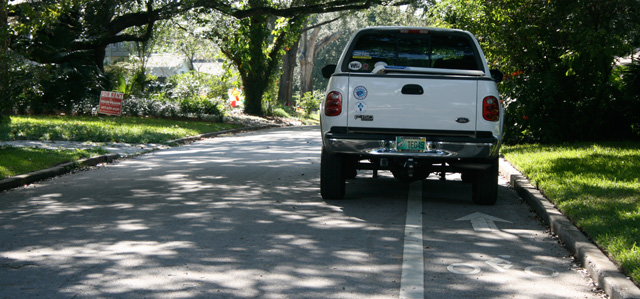More on Motor Vehicles in Bike Lanes
Question
Roger asked: But what about when the car is not making a turn (Re: The post on Right Turns)? For example, the road does not have any turns. Is a car allowed to use a bike lane? I thought the bike lanes were for the preferential and/or exclusive use of bicycles. Can a car be left parked in a bike lane?
Answer
Since the original post, in which I confirmed Roger’s statement that bicycle lanes are “preferential or exclusive”, I have discovered a recent change in the Department of Transportation’s (FDOT) Plans Preparation Manual that removed the “exclusive” wording from the definition of bicycle lanes.
Glossary of Terms
3. Bicycle Lane: A bicycle lane (bike lane) is a portion of a roadway (either with curb and gutter or a flush shoulder) which has been designated by striping, special pavement markings, and signing for the preferential use by bicyclists.
According to FDOT, they are now “preferential”, but not “exclusive”. Apparently, that was done to remove the conflict of vehicles being required to enter the bike lane to prepare for a right turn, as discussed in the other post.
If that is valid, the provisions in the statutes that use of the word “exclusive” would be rendered moot, and vehicles would not necessarily be prohibited from standing or parking in a bike lane for that reason. There are other considerations though.
s. 316.1945 – Stopping, Standing, or Parking Prohibited in Specified Places
(1) …. no person shall:
(b) Stand or park a vehicle, whether occupied or not, except momentarily to pick up or discharge a passenger or passengers:
6. On an exclusive bicycle lane.
The elimination of the word “exclusive” from FDOT’s definition does not mean that motorists may use bike lanes. Although there is no specific statement in the statutes that says “Motor vehicles shall not use bike lanes”, there is other directive language.
The typical bike lane is 4-5 feet wide. That is obviously narrower than the average motor vehicle. Vehicles are required to stay within a single lane and drivers would not be in compliance if the vehicle is partially within a bike lane.
s. 316.089 – Driving on Roadways Laned for Traffic
Whenever any roadway has been divided into two or more clearly marked lanes for traffic….
(1) A vehicle shall be driven as nearly as practicable entirely within a single lane….
If a motor vehicle is parked in a bike lane, it could be deduced that the vehicle was moving before being parked, and was moving partially within the bike lane, a violation of the above statute. That is similar to the successful argument used for cars parked facing the wrong direction and against the flow of traffic.
The counter to that might be that the vehicle was driven as “nearly as practicable” within the same lane and it was necessary to use more than one lane to arrive in the parked position.
The other argument that I had used may not be useful with the change in FDOT’s definition of bike lanes. It related to official control devices, which includes the roadway markings and signage designating bike lanes.
s. 316.003 – Definitions
(23) Official Traffic Control Devices – All signs, signals, markings, and devices … for the purpose of regulating, warning, or guiding traffic.
As directed by statute, the Department of Transportation adopted a uniform system of traffic control devices.
s. 316.0745 – Uniform Signals and Devices
(1) The Department of transportation shall adopt a uniform system of traffic control devices for use on the streets and highways of the state.
The Manual on Uniform Traffic Control Devices ( MUTCD)
Bicycle Lane – A portion of a roadway that has been designated by pavement markings and, if used, signs for preferential or exclusive use by bicyclists.
s. 316.074 – Obedience to and Required Traffic Control Devices
(1) The driver of any vehicle shall obey the instructions of any official traffic control device….
There is no question that FDOT can selectively use certain official control devices from the MUTCD, and that they require compliance. Less certain in my mind is whether FDOT can redefine bike lanes and eliminate the “exclusive” wording, effectively of rendering those provisions of the statutes moot. Those are legal and legislative questions beyond the scope of this site.
In any event, the practical effect of the change is insignificant. Motorists must remain in a single lane and cannot enter the bike lane, except as discussed earlier. If certainty is needed, “No Parking – Bike Lane” signs may be appropriate.


0 Comments on “More on Motor Vehicles in Bike Lanes”